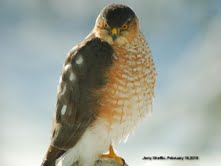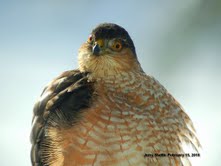
Raptor Identification - Sharp-shinned Hawk

If you have any photos of Sharp-shinned Hawks that you would like to contribute, please e-mail them to us with a caption and the photographer's name (but be aware that we must be selective of which photos we include because of space limitations for our website). |
Click on each photo for a description and a bigger picture
 |
 |
||||
 |
 |
||||
 |
 |
||||
 |
|||||

|
 |
||||
 |
 |
||||
 |
 |
||||
 |
 |
||||
 |
|||||
 |
 |
||||
An immense amount of information concerning Sharp-shinned Hawks can be learned from the following article about Accipiters, reproduced (with modifications) from the February 2001 issue of CPF's Talon Tales. The article was written by Marcel Gahbauer.
|
The vast majority of the time, raptors misidentified as peregrine falcons are in fact accipiters: sharp-shinned hawks, Cooper’s hawks, or northern goshawks. This Species Portrait will describe the identifying features, natural history, distribution, and conservation status of each of the three species of accipiter found in North America. Accipiters are hawks characterized by long tails and short, broad wings. They are the "true" hawks in that accipiter is Latin for "bird of prey". However, the original derivation of the word is thought to be from the Greek aci ("swift") and pteron ("wing"), referring to the speed and agility of these birds. The sharp-shinned hawk is named after a prominent ridge on its tarsi (despite the tarsus being analogous to the arch of the human foot rather than the shin). Its scientific name, Accipiter striatus, refers to the heavily streaked underparts of the juvenile, which was described before the adult. The Cooper’s hawk, Accipiter cooperii, was named in honour of New York ornithologist William Cooper. The northern goshawk derives its English name from the Anglo-Saxon gos and havoc, meaning a hawk which hunts geese. Its scientific name is Accipiter gentilis, meaning "noble hawk", a reference to the fact that only those of an elevated social stature were permitted to use this bird for falconry in mediaeval times. Identification:
Distribution: Natural history: Accipiters tend to nest in medium to large forests, and in general show a preference for areas relatively undisturbed by human activity. They may use either existing nests (often those of crows), or construct their own out of sticks, strips of bark, grasses, and feathers. Nests are normally situated near the trunk of a tree; the sharp-shinned and goshawk prefer conifers, while the Cooper’s is less particular. Courtship generally takes place relatively near the nest, and may involve a variety of aerial dives and swoops, performed alone or as a pair. Though rarely heard through the rest of the year, accipiters can be quite vocal during courtship. All three species give a variation of a call consisting of sharp "kak" notes. Once nesting has begun, accipiters tend to be very shy and reclusive. Even when an active terrritory is discovered, it can be difficult to pinpoint the actual nest. All accipiters are very protective of their territories, but none more than the goshawk, which is absolutely fearless and does not hesitate to strike any intruders, including humans. The eggs of accipiters are off-white, usually with a faint bluish or greenish tinge and spotted or lightly streaked with brown. Those of the sharp-shinned and Cooper’s hawks average 39 mm (1.5") in length, while the goshawk’s eggs are 59 mm (2.3") long. Incubation requires 32 to 36 days for the smaller species, and 36 to 38 days for the goshawk. Fledging times are also related to the size of the species: 24 to 27 days for sharp-shinned, 27 to 34 days for Cooper’s, and 35 to 42 days for goshawks. Sharp-shinned hawks may be independent within less than a month of fledging, but juvenile Cooper’s and goshawks remain with their parents for four to six weeks. Like peregrines, accipiters acquire adult plumage toward the end of their second summer. Only a small fraction of accipiters breed before reaching full maturity, and as many as half of goshawks wait until their third year. Though seldom seen by most people during the spring and summer because of their retiring habits, accipiters become quite conspicuous during the fall when sharp-shinned hawks in particular migrate south in large numbers. Those accipiters which remain in the north for the winter are frequently sighted, as they often stake out bird feeders for easy hunting. A backyard with an active feeder and nearby cover in the form of a dense bush or tree is ideal. Of the "backyard peregrines" reported to CPF, 95% or more are in fact accipiters, mostly Cooper’s hawks because of the close similarity in size. While the peregrine is a highly skilled hunter, it is adapted to aerial pursuits, and would actually have very little success if it attempted to hunt from a low perch in the manner of an accipiter. Conservation: |
© Canadian Peregrine Foundation